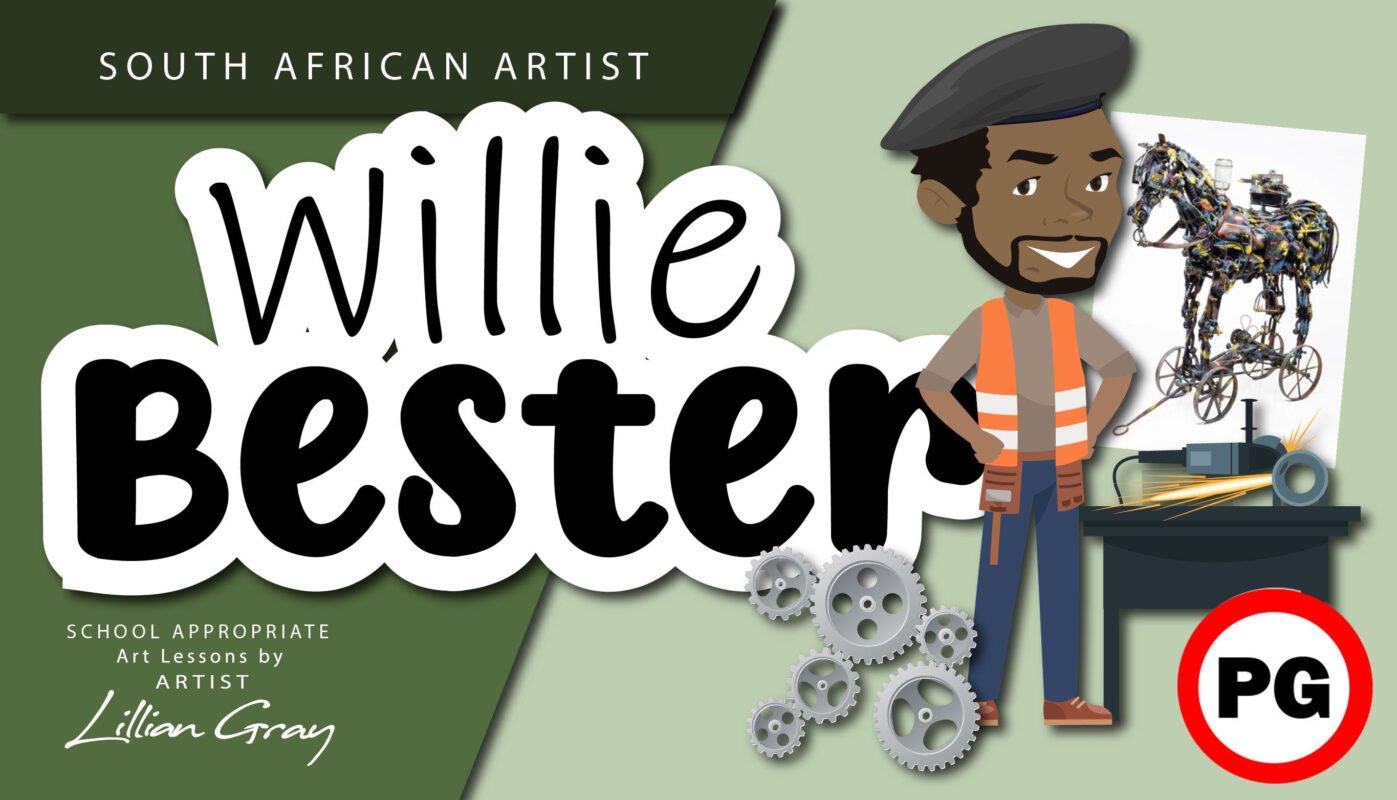No products in the basket.
7 Elemente van Kuns
Artist Willie Bester explained for younger students.

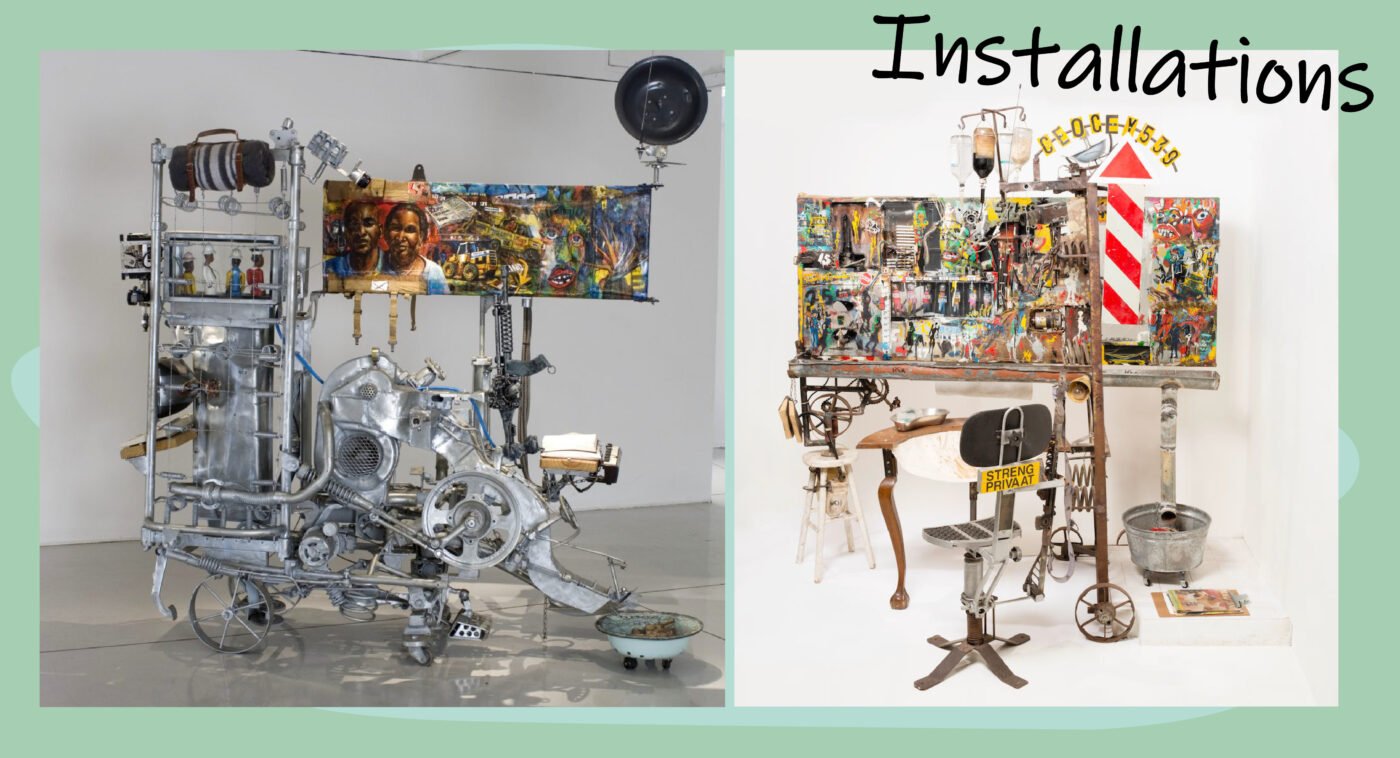
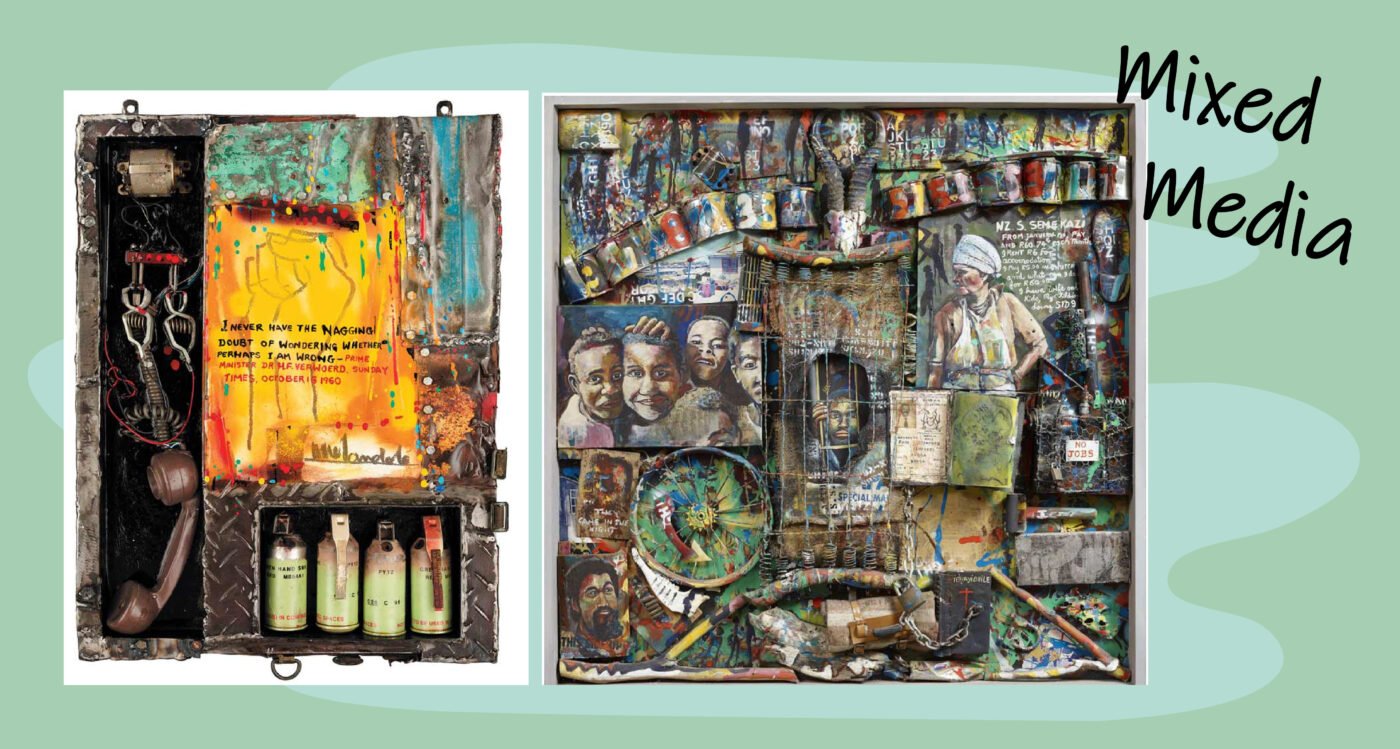
Please note we have two videos on this artist. This one is for our younger students and a more in-depth video for our older students.
Who is artist Willie Bester?
Willie Bester is a respected artist globally. He uses various mediums, such as watercolours and oil paints, but he is most known for his intricate, complex collages and metal sculptures. He collects scrap metal and trash to create artworks that tell people’s stories.
His art is classified as Resistance Art. That is because Willie Bester stood up against the unjust Apartheid System in South Africa.
The story of artist Willie Bester.
Willie was born in 1956 in a small town in South Africa. Now 1956 is an important date: It was the time of Apartheid in South Africa. Now Apartheid was a system that separated people by race into four racial categories: White people, Coloured people, Black people, and Asians. This system was super unfair.
Apartheid Explained
Let’s imagine we split each of different lengths – short and tall people. Then we make rules saying that short people cannot go to the beach and are not allowed to go to a good school. Only tall people are allowed to live in nice houses. Then we make all short people feel ugly and stupid and tell them they are not allowed to complain.
These rules might seem really silly to you, but so is sorting people according to their skin colour. We do not get to choose our length when we are born; in the same way, we do not get to choose our skin colour or race. It is not within anyone’s power to change this.
So Willie witnessed these silly Apartheid rules and violence between the different races in South Africa. He often saw white people being very cruel to people of colour.
Willie’s childhood
Willie’s troubles with race started at birth because he never quite fit into the mould. His father was Xhosa, a black man, and his mother was coloured. Back then, it was against the law for people of different races to marry, so he was born a crime. His parents were categorised as having a mixed-race relationship. They were not allowed to live together. The Apartheid government wanted to split the different races, so there was a neighbourhood for coloured and black people. How crazy is that?
Children of colour were so poor they didn’t have any toys to play with. As a child, Willie started making cars out of wire. He loved shaping the wire and became good with it. He started selling his wire cars to other children. That was when Willie realised his art could make him money.

Deciding to become a full-time artist.
As a young man, he joined the army but later became a full-time artist. During the 1980s, the resistance movements that stood up against Apartheid inspired him. He wanted to be a part of the movement, a part of the resistance, a part of breaking down Apartheid, a part of creating a new, just world. In Cape Town, Bester met many exciting people who opposed the apartheid system, openly criticising the government. This was very unusual at the time.
You see, Freedom of speech was not allowed in old South Africa. That meant people could not say how they felt about the government. Since Willie couldn’t just stand up and shout “Stop Apartheid” without being arrested, he decided to use his art to talk instead. He started creating art showing people how unfair the Apartheid government was.
The Group Areas Act explained.
Let me explain one of the cornerstones of the Apartheid System to you. It was called the Group Areas Act. Now back to my example of people being sorted according to their length. Once we have split the people into two groups, we can then clearly see there are way more short people than tall ones. However, we don’t want short people to live with tall people. We want tall people to have all the nice houses. So we divide the country into sections. We give a nice large area to the tall people. And the small terrible areas to the many, many short people.
And this is what the Apartheid government did, but according to people’s races. At the time of Apartheid, only 20% of South Africa was white people. 70% were Black, and the other 10% were Asians and Coloured people. They divided South Africa into sections. On this map, you can clearly see only a tiny amount of land was restricted for the other three races. The rest was all given to the white people, even though they were the minority in South Africa. Certain races were allowed to live in certain areas and not mix with others.
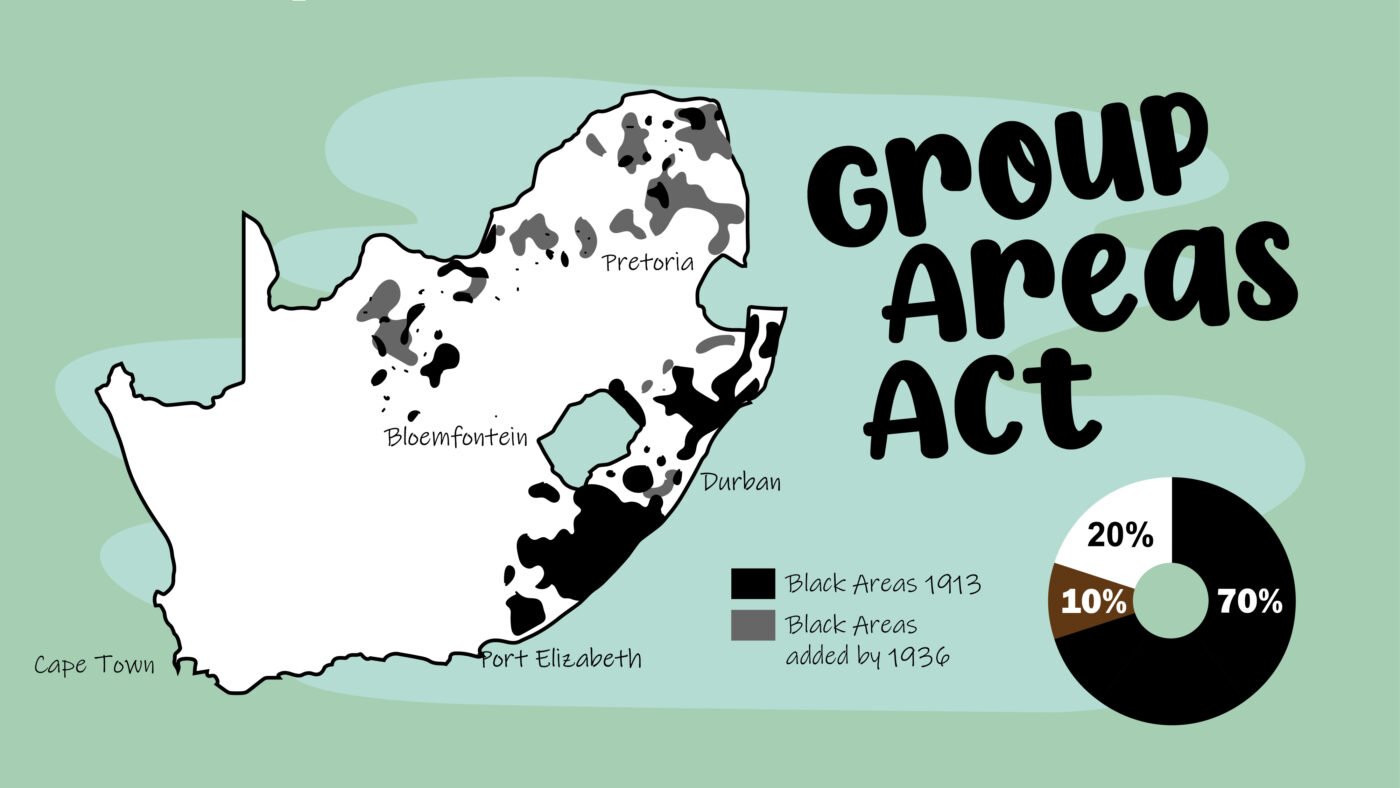
Forced Removals Explained
So now, what if people who weren’t white were already living in nice areas? Well, the government moved them. They would warn them, telling them they could no longer live there, and eventually sent bulldozers to their houses so they could build new neighbourhoods for the white people.
In the artwork Forced Removals, Willie Bester depicts the destruction of District Six in Cape Town. These removals were usually sudden and violent, with police and soldiers entering the townships. These forced removals were an emotional time for those families, forced to leave their homes with only the possessions they could carry. Townships such as Sophiatown in Johannesburg and District 6 in Cape Town are two examples of flourishing communities that the Apartheid Government destroyed.
How would you feel if the government had bulldozed your house?
Living Conditions in Apartheid South Africa
Willie also wanted to show the world how black people lived in South African townships. He had the idea to collect the rubbish and scrap metal from the streets they lived in to depict the living conditions. So he built collages of townships using trash from the actual townships. His artworks often incorporate photographs and newspaper clippings from the media. He also often cuts out words or paints text on his artwork.
He loves using found objects such as tin cans, car tires, scrap metal, and road signage. He sources objects from the streets of townships, rural areas, scrap yards, hardware stores, hospitals, and power stations.
Migrant Labours Explained in Apartheid South Africa
Did you know one of the key driving forces behind the Apartheid System was money? They needed cheap labourers to work in the mines. White people wanted to keep black people poor and uneducated.
Willie has created various artworks depicting this predicament. Previously, I explained to you the Group Areas Act, where the government forced people that weren’t white to live in specific areas.
Now, these homelands did not have many resources, and black men could not find jobs in these areas. They were forced to leave their families behind and go and work in the cities. In the cities, all the men had to live together in horrible conditions; most worked in the mines. They were paid very, very little money and were promised a pension once they retired.
This specific artwork by Willie Bester focuses on one migrant labourer called Semekazi. In the middle of the artwork, we see Semekazi and his bed being changed into a prison.

The bed is connected to a chain with a lock showing how Semekazi is a prisoner of the apartheid system.
At the top of the artwork, we see all these tins lined up with numbers. This comments on how the apartheid government only saw people as numbers.
He worked for years and years in the mines of South Africa, but when he applied for his pension, he was told that he was listed as dead and was not allowed to get any money. This was often the case with a lot of migrant workers.
He never stood a chance of getting a retirement with his family in the Transkei. Although the work tells the story of Semekazi specifically, it was the sad truth and reality for many black people in South Africa.
Another artwork that shows the economic motives behind the Apartheid system is this fantasy machine that WIllie constructed. Instead of using petrol as fuel, l uses poverty to keep it moving (the Poverty Machine.)
Characteristics of Willie Bester’s Artworks
Willie’s artworks are complex and tell real-life stories. He often uses cutting from newspapers and official headlines and quotes.
Some reoccurring elements in Willie’s works are bright paint splashes, the use of numbers, tin cans, shoes, road signs, metal plates, frames, wheels, and gears. He uses spades to make funky musical instruments. He often includes guns, bullets, and even bombs in his artworks to depict violence and war.
He often made animals from gears, spanners, and machine parts. Each animal was a symbol for a specific story he wanted to tell. The horse refers to the story of the Trojan Horse in Ancient Greece. It represents a nasty trick. Police dogs represent the Apartheid Government.
Artwork Hamba Kahle 1993 Analysed
One of Willie’s most famous works is Hamba Kahle, which means “go gently.” It is about a South African Freedom fighter, Chris Hani, that was killed. Willie used a bicycle wheel to frame the painting of Hani. Artist Willie Bester used various cutouts from newspapers and photographs to depict the circumstances of Hani’s death. This painting has many symbols, but I would like to point out the symbol for peace – a dove placed over a machine gun.
In the bottom right-hand corner, we see an image of a miner whose eyes are crossed out, showing the fatal record and tragedies that occurred in South African mines.
Just above him is an old banknote showing the capitalist motivation behind mining in South Africa and all the suffering it has caused amongst the black population.
At the bottom of the image, we see a tin guitar. To me, this symbolises a community struggling to find joy under oppression.
Above the guitar, we see a yoke, indicating the oppression of most South Africans in this time.

Installation Artwork Apartheid Laboratory 1995 Analysed
Here is one of my favourite installation art pieces by Willie. It’s a human sorting machine.
Apartheid Laboratory (1995) It is a visual metaphor for how the National Party sorted people in South Africa between 1948 and 1991.
It is a fantasy machine constructed from wires, plugs, switches, and wheels. The purpose of these circuits is to sort people into different racial categories. Each mannequin is inscribed with a number and assigned a group. These wooden figures wear chains around their ankles. Showing they are bound by birth because of their race.
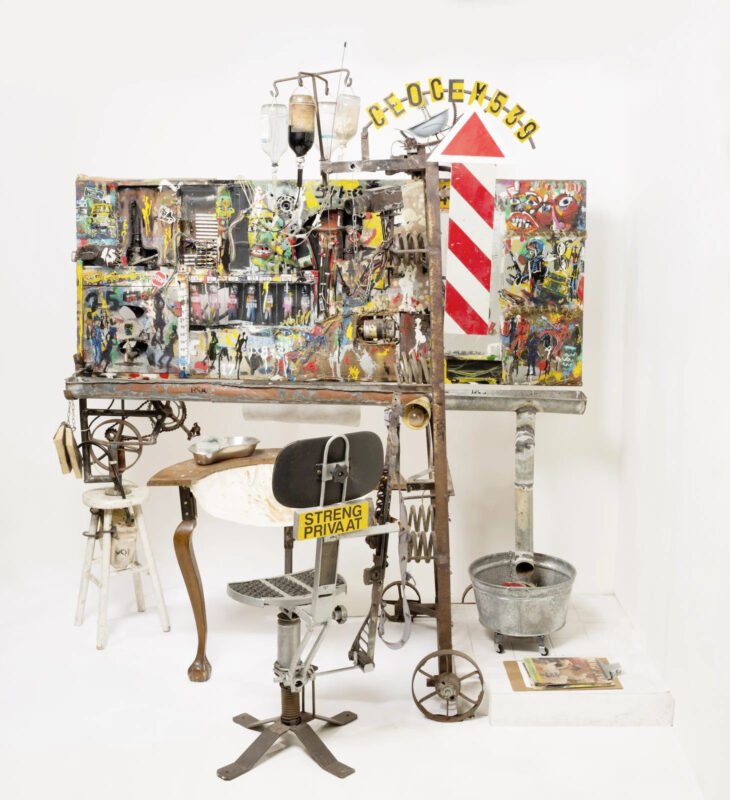
Once each individual has received their classification, they are assigned to the designated educational system for their group. At the bottom of the panel, a gutter catches the ‘lowest’ racial order, ‘society’s refuse,’ channelling it into a waste bin on the white tiled floor.
The clinical conditions of the laboratory, the surgical instruments, and the drips all work to suggest that this system of racial segregation has scientific grounding. However, the CCTV cameras reveal the system to be far less secure in reality. Government surveillance and police intimidation maintained popular support for Apartheid.
The Purpose of Willie Bester’s art
Willie believes it’s essential to keep the memory of Apartheid alive so that people can prevent repeating the atrocities that occurred. He says he cannot be quiet and remain silent when he sees wrongdoing. “I believe that we must protest against that which is wrong.”
Willie’s story is of a minor, impoverished boy raised in the oppressive apartheid system in South Africa, and it shows how this boy finally breaks free and finds his voice through art. It shows us that art can speak, tell us stories, and, more importantly, has the power to change people’s minds.
Willie’s artworks help us to remember South Africa’s dark past under Apartheid. It shows us how unfair the system was and prevents us from creating a silly system like that again. His work has severely impacted the changing of people’s ideas of how ridiculous it is to classify people according to skin colour.
It’s important to note that not all white people were pro-apartheid. Some were also opposed to it, but remember, the government at the time owned and controlled the media and drove a propaganda machine, brainwashing people.
Willie Bester’s Artwork Post-Apartheid
After apartheid ended, Willie Bester continued to produce artworks. Everybody believed things in South Africa would change for the better after 1994. However, there are still a lot of injustices and inequalities in the new South Africa. Willie continues to expose greed, poverty, and corruption in society and the government.
Today he is a celebrated artist who has exhibited across South Africa and globally. Willie has also won various awards for his fantastic contribution to protest art. He has also been given an honorary doctorate in art.
Currently, Willie Bester lives in Kuils River in South Africa with his wife Evelyn and their three children. His house is an extraordinary expression of his individualism and artistic abilities. It looks like so much fun to live there.
And that’s the story of the fantastic South African resistance artist Willie Bester. You can buy our worksheets on Willie Bester at our Teachers Pay Teachers store
I am artist Lillian Gray, and I hope you enjoyed learning about this vital artist with me. Until next time.

